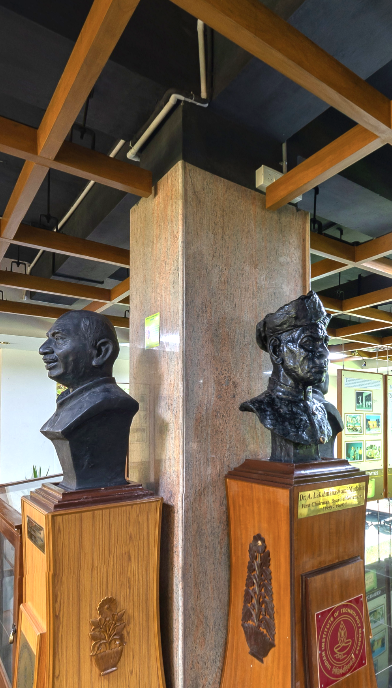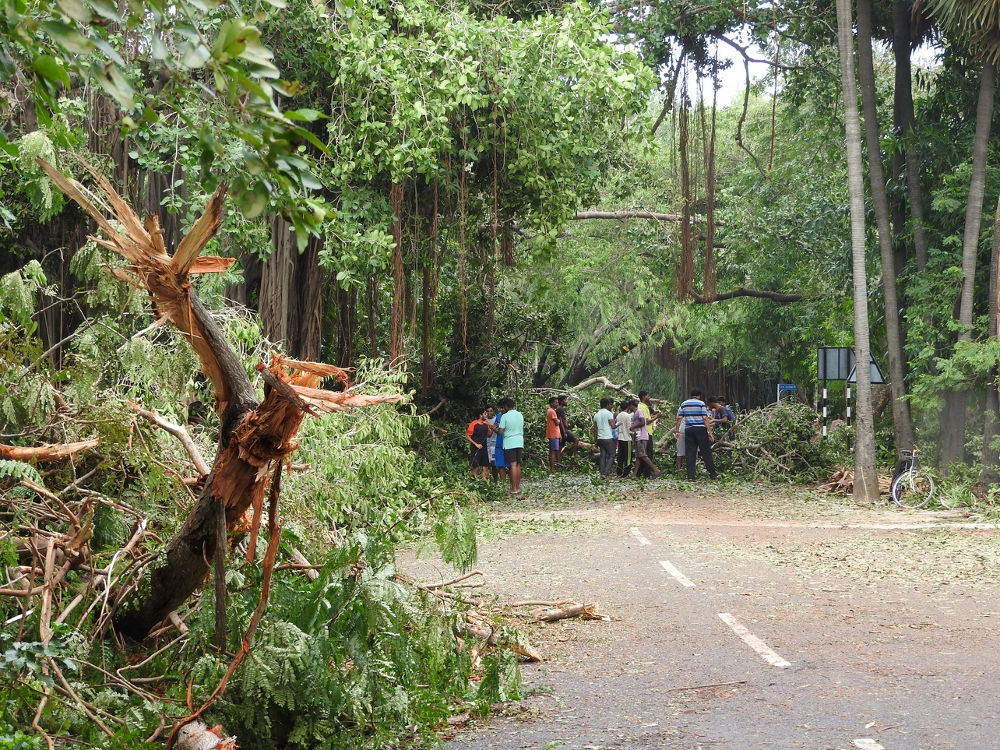
-
The Heaviest of Them All
Jan 23, 2018
Kumaran Sathasivam
In December 2016, a tropical storm that originated near the Malay Peninsula glanced the Andaman and Nicobar Islands and went on to make landfall at Chennai. This was Cyclone Vardah. A Very Severe Cyclonic Storm according to the classification of the Indian Meteorological Department, Vardah weakened a little before it struck the city. Even so, the wind gusted most powerfully—the speeds are reported to have reached 120 kilometres per hour at the port. The cyclone caused devastation in the city, uprooting a large number of trees.
Many trees fell in the IIT Madras campus too.

December 2016: Cyclone Vardah uprooted and snapped trees when it made landfall.
We have a few souvenirs of Cyclone Vardah at the Heritage Centre. They are roughly of a form that a mathematical textbook might describe as a vertical cylinder of circular cross-section. The shorter of these cylinders are high enough to reach your waist. And their girth is such that if you wrapped your arms around one, your fingers might just touch. These are sections of trunks of trees, probably neem trees, that were toppled by Cyclone Vardah in the campus.
These sections were stripped of their bark, smoothed down and varnished by the carpentry unit of the Central Workshop. So well polished are they that they present the appearance of water-worn rocks. If you tried to lift them, your impression that they are rocks would be strengthened—they are surprisingly heavy. Actually, they are so heavy that you would need to be a trained professional to lift or move them.
These pieces of wood could be the heaviest objects we have inside the Heritage Centre, barring some of the furniture. I believe they are heavier even than the stone laid at the inauguration of IIT Madras, on 31 July 1959. And that stone is set in a frame of concrete!
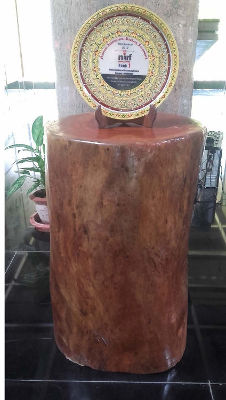
One of the souvenirs of the cyclone, serving as a stand for a prestigious award.
But a couple of years back, we had on display items that were probably even heavier. We had them here as part of a thematic exhibition on the wave energy project of IIT Madras.
IIT Madras began working on this project in the 1980s. It was aimed at producing electricity from wave energy. There is abundant energy in ocean waves worldwide. It derives from wind energy, which in turn is fuelled by the sun. But surprisingly, there were few serious efforts to tap it prior to the 1970s.
In 1973 there was an oil embargo. Oil prices shot up. Though the embargo was lifted after a few months, its effects lingered. The oil consuming countries began looking at energy from alternative sources. One of these sources was wave energy. A host of countries, notable among them Japan, the UK and Norway, initiated efforts to tap wave energy. A number of ingenious devices were conceived of.
The technology IIT Madras developed involved the entrapment of a column of air above the surface of the sea. As the surface rose and fell with each wave, the column of air oscillated. This oscillating air column drove a turbine, producing electricity. This sounds simple, but in fact there was a lot of complex engineering involved.
The project went from the lab to the ocean. A power plant was built at the end of a breakwater at Vizhinjam, near Trivandrum. Tremendous difficulties were faced in working in the marine environment.
A 10 metre high concrete structure, known as a caisson, was built on the Vizhinjam beach and floated out into the sea like a small ship. It was made to settle on a bed of stone prepared on the floor of the sea.
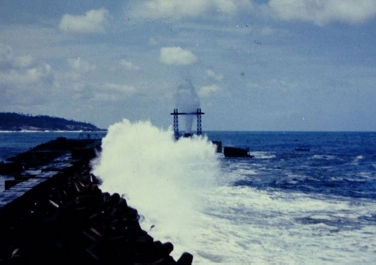
A power plant was built at the end of a breakwater. Working in the marine environment was very difficult.

A bridge was built from the breakwater to the caisson.
The turbine was installed at the top of the caisson, and measurements began. The initial results were disappointing. But subsequently, different turbine configurations were developed and tested, and a successful technology emerged. The wave energy plant began producing power steadily.
Eventually the wave energy project led to the birth of a new organisation entirely devoted to technologies related to the ocean, the National Institute of Ocean Technology (NIOT). IIT Madras researchers continued to work on the wave energy project in collaboration with their NIOT counterparts.
The wave energy plant at Vizhinjam was run for many years, during which period the electricity it produced was used to desalinate sea water. The drinking water produced by the desalination plant was supplied to the local community.
For the exhibition at the Heritage Centre, we got from NIOT a beautiful threedimensional model of the wave energy plant at Vizhinjam. NIOT also lent us the first turbine that had been tested at the caisson and a three-dimensional model of a wave energy device they were developing for powering navigation buoys. From the Department of Ocean Engineering we got a 1:10 model of the great caisson that had been installed in the sea at Vizhinjam. This was an exotic-looking affair, made of thick-walled acrylic blocks held together by metal screws. The model caisson had been fabricated in West Germany in the early days of the wave energy project. It had been placed in a wave flume and parameters such as the air pressure and velocity measured.
The turbine loaned by NIOT was a full 2 metres in diameter. It was displayed outside the Heritage Centre, near the entrance. Casual viewers could have assumed the contraption was a windmill, which it was in a way.
The model of the caisson was very unwieldy. A forklift truck and a number of helpers brought it over from the Department of Ocean Engineering. The model was slid on rollers into the middle of the Heritage Centre, and that is where it throughout the exhibition and the better part of the following year.
The Department of Ocean Engineering had given us the model to keep. Finally it was time for a change. The space at the centre of the hall was needed. We decided to place the caisson model outside the Heritage Centre, on the lawn near the entrance, where the windmill-turbine had stood.
Taking the caisson model out of the Heritage Centre turned out to be a greater challenge than bringing it in had been. Ten able-bodied assistants struggled to move it. There was much shouting of directions and encouragement as they strained to lift it on to a trolley. I began to think that someone would be injured or something damaged.
But all was well in the end. The model was moved out, and it slid into place easily. Curiously shaped, exotic looking, it stands outside the Heritage Centre, drawing the attention of all who pass by, possibly mystifying them. I like to think that they are reminded of the Louvre, with its glass pyramid.
Kumaran Sathasivam
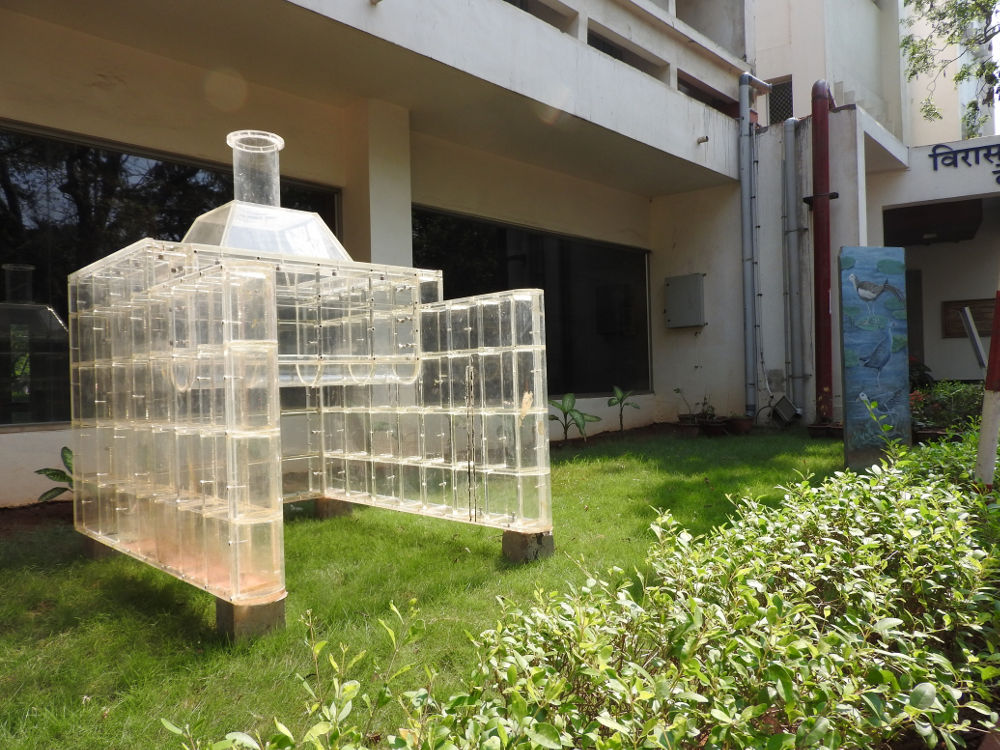
Like the glass pyramid of the Louvre
Your response to Letter from Heritage Centre is welcome. Please send mail to heritage@iitm.ac.in
The Heritage Centre is located in the ground floor of the Administration Building, IIT Madras. It is open on weekdays from 9.30 am to 5.30 pm.
- Contribute
to the Centre -
Monetary
Support - Digital
Material

